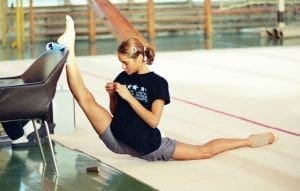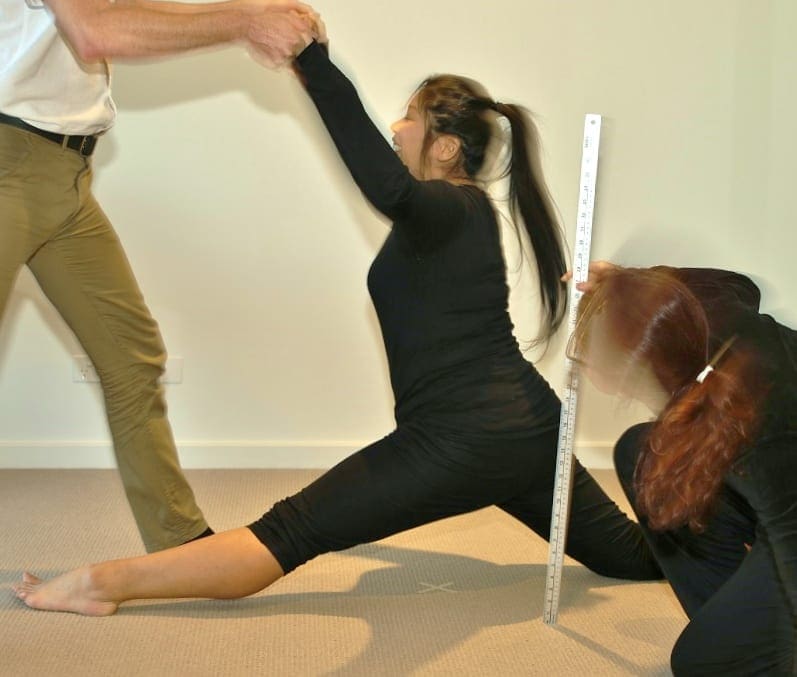There are many unanswered questions in the universe. How many decimal places are there in Pi? Is there a unified theory of physics? How does a shepherd count his flock without falling asleep?
It’s possible we’ll never know.

Photo: Russian rhythmic gymnast Irina Chaschina stretching. This is an example of an oversplit, or a split that exceeds 180 degrees. Mollerjoakim, CC BY-SA 3.0 http://creativecommons.org/licenses/by-sa/3.0/, via Wikimedia Commons
Some questions, however, can be answered. For example, if a therapeutic massage is meant to lengthen and relax your muscles, then can it help you to do the splits?
Meet Stef.
She has never been able to do the front splits before, but she wants to. Ambitious. I like it.
Stef is a client of my personal trainer Nez Jonsin, and one grey Saturday afternoon Stef came over to Nez’s private studio in Ascot Vale to find out if a massage could get her closer to the ground.

We started off by finding out our starting point. Stef had a go at doing the front splits and we used a metal ruler to measure the distance between her groin and the floor.
Our starting groin height was 29cm.
Anatomy considerations
I had a think about all the muscles we would need to lengthen and relax: iliacus, psoas major, rectus femoris, tensor fascia lata, the adductor group, hamstrings, gastrocs… The more I thought about it, the more I realised that nearly the entire body is involved in the splits! So we had our work cut out for us.
To begin with I conducted a quick hip, knee and ankle joint assessment to rule out any joint restrictions, especially in the hips. Once we concluded that the joints would not hold her back, we turned to the muscles.
Therapeutic stretching
Next came deciding how to approach the lengthening process. I knew already that PNF and isometric stretches can neurologically inhibit muscles, so we started there.
We worked our way through the major muscle groups with some active isolated stretching, and then moved into a few isometric (30+ second) stretches. Each muscle stretched was massaged with compression broadening between each stretch.
Applied massage
Next we got her onto the table and I applied some pretty standard effleurage (sweeping strokes), pétrissage (kneading, lifting and rolling) and deep long stripping on areas that felt dense, tight or restricted, being careful not to over-excite the muscles or make them tighten up in pain.
Finally we hit some of the major muscles such as the hip flexors, adductors and glutes with some compression broadening and lastly some long slow golgi stretches to both stretch and further neurologically inhibit the muscles we intend to lengthen.
The whole treatment process took about 45 minutes.

Then, just before Stef made attempt #2 (see photo), Nez took her through some foam rolling movements to provide increased proprioception, helping to get Stef’s brain to accept changes to the tissues. Because when you think about it, what tells the muscles what to do? The brain! So we need to appeal to Stef’s control centres as well as her physical structures.
Then we were ready to go back into the splits again. This time Stef actually felt like she needed some support as she went down, so I gave her my hands so she could balance.
We found that Stef had gained 8cm of depth, making a 28% increase.
Not bad! Stef descended from 29cm to 21cm in groin height.

Since then, Stef has managed to keep the new level of flexibility, which is great. No backsliding! However, in the three weeks since, she hasn’t yet managed to go any further.
I’ve been wondering if we had reached the current limits of her connective tissue (tendon, ligament, and fascia) cells, which can take between 3 and 6 months to replace themselves (sometimes as long as three years). It can take that long to significantly change shape. For this reason, Stef will need constant regular flexibility training and practise, ideally daily, to see lasting changes and get that groin to the ground.
But it still makes me wonder: what would happen if she came in for another massage treatment…?
